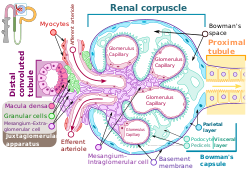This article needs additional citations for verification. (May 2015) |
| Macula densa | |
|---|---|
 Renal corpuscle showing the macula densa. | |
| Identifiers | |
| FMA | 86333 |
| Anatomical terminology | |
In the kidney, the macula densa is an area of closely packed specialized cells lining the wall of the distal tubule where it touches the glomerulus. Specifically, the macula densa is found in the terminal portion of the distal straight tubule (thick ascending limb of the loop of Henle), after which the distal convoluted tubule begins.[1][2][3]
The cells of the macula densa are sensitive to the concentration of sodium chloride in the thick ascending loop of henle. A decrease in sodium chloride concentration initiates a signal from the macula densa that has two effects: (1) it decreases resistance to blood flow in the afferent arterioles, which raises glomerular hydrostatic pressure and helps return the glomerular filtration rate (GFR) toward normal, and (2) it increases renin release from the juxtaglomerular cells of the afferent and efferent arterioles, which are the major storage sites for renin.[4]
As such, an increase in sodium chloride concentration would result in vasoconstriction of afferent arterioles, and reduced paracrine stimulation of juxtaglomerular cells. This demonstrates the macula densa feedback, where compensatory mechanisms act in order to return GFR to normal.
The release of renin is an essential component of the renin–angiotensin–aldosterone system (RAAS), which regulates blood pressure and volume.
- ^ Gonzalez-Vicente, Agustin; Saez, Fara; Monzon, Casandra M.; Asirwatham, Jessica; Garvin, Jeffrey L. (2019). "Thick Ascending Limb Sodium Transport in the Pathogenesis of Hypertension". Physiological Reviews. 99 (1): 235–309. doi:10.1152/physrev.00055.2017. PMC 6335098. PMID 30354966.
- ^ "Tubuloglomerular Feedback - an overview | ScienceDirect Topics".
- ^ Mount, David B. (2014). "Thick Ascending Limb of the Loop of Henle". Clinical Journal of the American Society of Nephrology. 9 (11): 1974–1986. doi:10.2215/CJN.04480413. PMC 4220766. PMID 25318757.
- ^ Guyton & Hall Textbook Of Physiology, 11th Edition 2006, p. 324